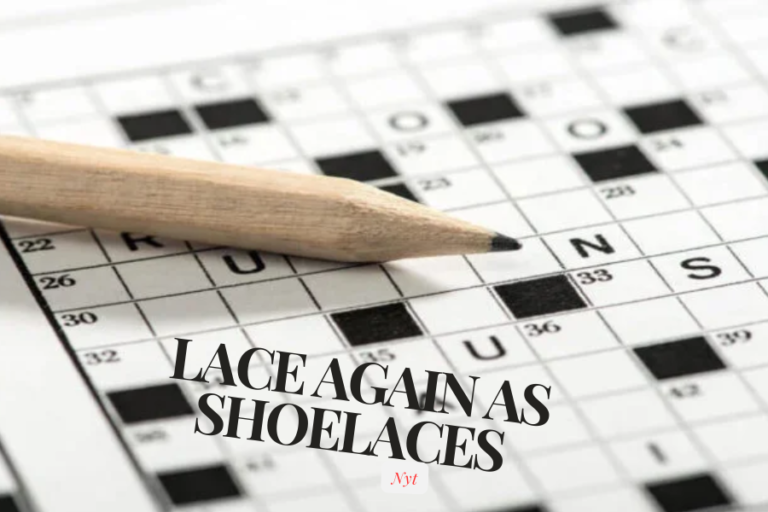Unveiling the Mystery: What Arouses Suspicion in Today’s Society? And More Explained Further Here…
For many fans, solving the New York Times Crossword Puzzle is a treasured ritual rather than merely a hobby. Pencils out, solvers convene at their tables once a week to take on a fresh problem. Filling in the squares isn’t the only task; we also need to analyze hints that put our vocabulary and cognitive abilities to the test.
“Arousing suspicion” is one particularly interesting indication that frequently surfaces. Puzzlers may embark on an intricate voyage through words and meanings with this phrase. However, what does it actually mean? We’ll explore this clue’s function in the NYT crossword and unearth more facets of its relevance. Come investigate why “arousing suspicion” is such a fascinating component of the puzzle, both in terms of solving it and having more general conversations.
The Hint: Creating Doubt on NYT
For those who enjoy word puzzles, the New York Times Crossword Puzzle is a treasure trove of answers and difficulties. One particularly captivating clue that frequently appears is “arousing suspicion.”
This phrase sparks curiosity and demands a deeper level of thought. It’s not merely about finding a synonym but grasping the underlying context and tone. When faced with this clue, your mind might wander through various possibilities.
You might consider scenarios where something feels off or dubious, where trust is in question. The challenge lies in conveying a sense of doubt without exaggeration.
Uncovering the answer can be a revelation. For instance, the term “fishy” perfectly captures the essence of suspicion—indicating that something might be amiss in what otherwise seems straightforward. Solving these clues transforms each crossword into a journey through the nuances of language.
Recognizing the Trace
There are numerous approaches to investigate the clue “arousing suspicion”:
Literal Interpretation: The phrase fundamentally implies something that casts doubt on someone’s intentions or behavior.
Synonyms: The hint may point you in the direction of a term that encapsulates the essence of raising doubts or mistrust.
Contextual Insight: The phrase may allude to a specific situation where suspicion would naturally emerge, depending on the crossword’s theme or the surrounding clues.
The process of solving the puzzle is made more interesting and demanding by the many viewpoints that each angle provides while approaching the clue.
Potential Responses
Here are some possible answers for the clue “arousing suspicion” that might fit different NYT crossword puzzles:
- SHADY: This word suggests something that seems questionable or dishonest, often hinting at dubious activities.
- FISHY: This term conveys a sense of suspicion or something that doesn’t quite add up, often used to describe situations that feel deceptive.
- SUSPECT: As both a noun and verb, “suspect” can refer to a person believed to be involved in wrongdoing or the act of finding something suspicious.
- ODD: “Odd” implies something unusual or out of the ordinary, which might raise suspicions.
- SKETCHY: This word describes something that seems unreliable or dubious, often evoking a sense of doubt.
- DOUBTFUL: “Doubtful” indicates uncertainty or a likelihood of being suspicious, fitting the clue’s meaning.
Each of these terms captures different nuances of suspicion, making them potential fits for the crossword puzzle.
Methods for Resolving
Try these approaches to solving the “arousing suspicion” clue:
Examine the Crossword Grid: Determine the required number of letters for the solution, and search for more clues by looking at words that intersect.
Examine Synonyms: Go over synonyms for “doubtful” or “suspicious” that make sense given the puzzle’s letter count and context.
Examine the Theme: See if there is a particular theme in the puzzle that could point you in the direction of the right solution. Themes frequently offer useful hints.
Look for Wordplay: Wordplay is a common feature of the New York Times crossword. Consider whether the clue contains a pun or has two meanings.
Employ Crossword Solving Software Use crossword dictionaries or internet solvers sparingly: To maintain the challenge, try to save your use of them for desperate situations.
Last Response
It can be difficult to solve the New York Times crossword problem, especially when the clues call for ingenuity. “Arousing suspicion” is one such clue that can cause puzzlers to pause for some time.
“Fishy” is the answer to this clue. This word sums up exactly how you feel when something doesn’t quite fit or appears strange. We frequently use this phrase in casual discussions when we sense that something is off, whether it be in someone else’s account or what we see firsthand.
Thus, keep in mind this the next time you hear the term “arousing suspicion”—in your day-to-day activities or while working through a New York Times crossword—and remember that it’s always a good idea to follow your gut!
Summary:
Word lovers adore the New York Times Crossword Puzzle, which provides a weekly chance to assess vocabulary and mental abilities. “Arousing suspicion” is a fascinating clue that frequently surfaces and forces solvers to reflect carefully on the definition of suspicion and its various manifestations. This clue is frequently answered with the word “fishy,” which sums up what seems strange or suspicious. The relevance of the clue, possible solutions, and methods for answering it are all covered in this article.
Facts:
- Clue Context: “Arousing suspicion” is a phrase used in the NYT Crossword Puzzle to indicate something that triggers doubt or unease.
- Common Answer: The term “fishy” is frequently used as an answer, reflecting a sense of suspicion or something that doesn’t quite add up.
- Synonyms: Other possible answers include “shady,” “suspect,” “odd,” “sketchy,” and “doubtful,” each capturing different nuances of suspicion.
- Solving Strategies: Effective methods include examining the crossword grid, considering synonyms, exploring the theme, looking for wordplay, and using crossword tools sparingly.
FAQ:
Q: What does the clue “arousing suspicion” mean in the NYT Crossword Puzzle?
A: The clue “arousing suspicion” refers to something that creates doubt or causes one to question the validity or integrity of a situation or person. It challenges solvers to think about terms related to suspicion and distrust.
Q: What is the most common answer for the clue “arousing suspicion”?
A: The most common answer is “fishy,” which conveys a sense that something is not quite right or seems deceptive.
Q: How can I approach solving the clue “arousing suspicion”?
A: Start by checking the number of letters required for the answer and the intersecting clues. Consider synonyms for suspicion, explore any thematic elements in the puzzle, and look out for wordplay. Use crossword dictionaries or online solvers as a last resort.
Q: What other answers might fit the clue “arousing suspicion”?
A: Other potential answers include “shady,” “suspect,” “odd,” “sketchy,” and “doubtful,” each reflecting different aspects of suspicion and doubt.
Q: Why is the term “fishy” used for the clue “arousing suspicion”?
A: “Fishy” is used because it perfectly encapsulates the feeling of suspicion—suggesting that something is amiss or does not seem right, akin to how a suspicious odor might indicate something wrong.
“Uncover captivating stories and deep dives into notable individuals at MediumPeople.com.”



